#ayodhya live news
Explore tagged Tumblr posts
Text

ટાટા ગ્રુપ ઉત્તર પ્રદેશના અયોધ્યા શહેરમાં મંદિરોનું મ્યુઝિયમ બનાવવા જઈ રહ્યું છે. આ મ્યુઝિયમ 650 કરોડના ખર્ચે બનાવવામાં આવશે. તેમના પ્રસ્તાવને મંગળવારે ઉત્તર પ્રદેશ સરકારની કેબિનેટે મંજૂરી આપી હતી. | Tata Group is going to build a museum of temples in the city of Ayodhya in Uttar Pradesh. This museum will be built at a cost of 650 crores. His proposal was approved by the Uttar Pradesh government cabinet on Tuesday.
#news#latest news#breaking news#live news#news in gujarati#latest news in gujarati#ગુજરાતી સમાચાર#gujarati news#ગુજરાત સમાચાર#તાજેતરના સમાચાર#Gujarati News Headlines#Uttar Pradesh#ઉત્તર પ્રદેશ#Uttar Pradesh news#ઉત્તર પ્રદેશ સમાચાર#Uttar Pradesh latest news#ઉત્તર પ્રદેશ તાજા સમાચાર#Uttar Pradesh breaking news#Uttar Pradesh live news in gujarati#ઉત્તર પ્રદેશ લાઇવ સમાચાર ગુજરાતીમાં#Ayodhya#અયોધ્યા#Ayodhya news#અયોધ્યા સમાચાર#Ayodhya live news#અયોધ્યા લાઈવ સમાચાર#Ayodhya latest news#અયોધ્યા તાજા સમાચાર#Ayodhya breaking news#Tata Group
0 notes
Text
राम मंदिर ट्रस्ट ने जारी की सूचना, कहा, रामलला के दर्शन का नही लगता एक भी रुपया; यहां पढ़ें पूरी डिटेल
राम मंदिर ट्रस्ट ने जारी की सूचना, कहा, रामलला के दर्शन का नही लगता एक भी रुपया; यहां पढ़ें पूरी डिटेल
Ayodhya Ram Mandir News: अयोध्या राम मंदिर में रामलला की प्राण प्रतिष्ठा के बाद बड़ी संख्या श्रद्धालु पहुंच रहे हैं, ऐसे में श्रद्धालुओं को किसी तरह की कोई परे��ानी न हो और वो आसानी से प्रभु राम के दर्शन कर सकें, इसके लिए श्रीराम जन्मभूमि तीर्थ ट्रस्ट की ओर से विशेष जानकारी दी गई है. अगर आप भी रामलला के दर्शन को जा रहें तो ये जानना आपने बेहद ज़रूरी है. इससे अयोध्या पहुंचने पर आपको किसी तरह की…

View On WordPress
#information#no cost#Ram Mandir#ram mandir ayodhya#ram mandir ayodhya live#ram mandir ka udghatan#ram mandir ki hai bari song#ram mandir live#ram mandir news#ram mandir song#ram mandir status#Ram Mandir Trust#ram mandir udghatan#Ramlala#single rupee
0 notes
Text
Ram Mandir Inauguration: PM Modi's 10 Empowering Messages
Ram Mandir Inauguration today is a historic moment for India. Prime Minister Narendra Modi delivered a historic address to a gathering of 7000 including devotees, celebs and who is who of society after the Pran-Pratishtha event at the Ayodhya Ram Mandir, marking a significant moment in India’s cultural and religious history. In his speech, the Prime Minister declared, “January 22, 2024, is not…

View On WordPress
#ayodhya#ayodhya live#ayodhya ram mandir#ayodhya ram mandir inauguration#ayodhya ram mandir live#ayodhya ram mandir news#modi speech#modi speech today#Narendra Modi#narendra modi speech#pm modi ayodhya#pm modi ayodhya speech#pm modi in ayodhya#pm modi speech#pm modi speech today#PM Narendra Modi#pm narendra modi speech#pm narendra modi speech latest#Pran-Prathishta#prime minister narendra modi#Ram Lalla#ram mandir ayodhya#ram mandir ayodhya live#Ram Mandir Ceremony#ram mandir in ayodhya
0 notes
Text
DAY 6101
Jalsa, Mumbai Nov , 1, 2024/Nov 2 , Fri/Sat 12:08 am
🪔 ,
And the wishes to the Ef ..
November 02 .. birthday wishes to Ef Erlika from Indonesia 🇮🇩 .. Ef Abhijit Jagtab from Pune .. and .. Ef Dipagala Gala .. 🙏🏻❤️🚩
November 01 .. birthday wishes to Ef Vishan Lal 🪈 from Gurugram .. Ef Honey Aishu from Bangkok - Thailand 🇹🇭 .. Ef Nouranne Achraf from Egypt / France 🇪🇬🇫🇷 .. Ef Pankaj Shukla from Indore .. Ef Shubhra Rattan .. and Ef Somraj Mane from Kolhapur .. 🙏🏻❤️🚩
..
may this new year in your lives bring greater joy and prosperity ❤️🌹


Govardhan Pooja ... नमस्कार 🙏
and the festivities continue .. as do all the rituals .. and among all this Australia declares the month of October as a heritage month of Hindu festivities .. grace and divine blessings ..
But the intimacy of soft celebrations and the adherence to the control of many environmental obligations is revered .. as another year of the year of Lights ends , to another day of light ..
The intrigue of religious festivities .. their time and date and occasion still brings a wonder to many .. indeed to a great many .. and the readings of our Ef Sudhir and his dedicated research on the subject does evoke curiosity .. and awareness ...
The Calendar
There are two lunar calendars in the Jyotish Shastra… One is Purnaant and the other is Amaant…
There's a gap of 15 days between the two, although the order of the months are the same…
For instance, Deepavali's Lakshmi puja is on Purnaant Kartik Amavasya… while the same day is Amaant Ashwin Amavasya in some states…
So, the festival has a different reason in each region, and one common reason at the national level…
Like, the South, where the Lakshmi puja night of diwali is to recall the victory of Krishna over Narakaasur… In the North, it's for the return of Shri Ram to Ayodhya…
The concept of a civilisation made of many cultures dates back to the Treta Yug…
Diwali is celebrated for different days in different places… One day, three days, five days and eleven days… depending on the local history…
Yes… the different calendars, different cultures, but the same festivals, and the same civilisation…
You know, what… I think it's always an advantage when we do something that has no precedence… when there is nothing to refer…
This organisation of a nation is first envisaged in the chronicles of the satyug… each kingdom was called a country… group of countries was a region… the collective of regions was called a nation…
In Hindi - देश, प्रदेश तथा राष्ट्र…
What calendar do I follow?
I follow Rishi Varāhamihira's Brihat Samhita… In that, there is no need of dividing time into months and years…
The movements of cosmic objects don't need a calendar to have months and years… Only days are enough… Just count the days from a no-moon or a new-moon… the patterns are measurable and predictable…
Like,
The diwali always happens on the same no-moon night… regardless of which month in which state…
Thus, all the differences are dissolved in the universal medium… 🙂
About the light…
Darkness is not displaced by light… darkness is eliminated by light…
तमसो मा ज्योतिर्गमय।
Easiest way to do it is: Use one lamp to light the next… A series of lamps… Hence, Deepavali… Deep + Aavali - strings of light…
एक ब्रह्म है… एक सत्य है… एक ही है परमात्मा… प्राणों से प्राण मिलाते चलो.
my obsessed gratitude ..
my love and regard ...

Amitabh Bachchan
108 notes
·
View notes
Text

because my very real-time post about my garden blooming in freezing weather apparently wasn't up to par, I will grant the boon of @zeherili-ankhein and make a post about what happens when one asks Sri Krishna for water.....
Careful what you wish for...sometimes spurring a river to quench thirst can result in consequences greater than one is prepared to accept...
A long, long time ago, in a land far beyond India, Lord Ram and Lady Sita lived 14 years in exile from their kingdom, called Ayodhya.
During their journeying in the forest, they were often without water. Sita was becoming exceedingly weak from exhaustion- she was a princess from a fine kingdom-not a woman built for the long hot days of the dense jungle forests.
On a day when her constitution was rapidly weakening, Lord Ram went in search of water. But as the life force of his Shakti was fading, his journey came without luck.
A peacock heard of the Lady's failing constitution and would not let the incarnation of Lakshmi perish, in exile, in an untamed wilderness. The peacock greeted Lord Ram and offered to guide him and his family to refuge, and to the water which they needed so desperately in order to survive. However, with every action there is an equal and opposite reaction.
As the forest was dense, and the peacock was quicker to fly than to walk, only the dropping of the peacock's feathers from his tail for a marker would allow the travelers to arrive safely to the water source- in time to save the life of the Lady Sita.
With each dropped feather, the life's journey for our peacock came nearer to its close. When the family finally arrived to the water's edge, the peacock lay at the bank- the feathers missing from his once glorious tail.
In return for such a sacrifice, Ram promised to ever honor the peacock. In each incarnation following, the Lord Vishnu adorns himself with gifted feathers shed from a peacock who found its mate.
As the 8th Avatar of LakshmiNaryana, Sri Krishna and Devi Rukmini continued to honor the sacrifice from the life of the devoted peacock they met as Ram and Sita. Sri Krishna wore the feathers in his crown and MaaRukmini tended the birds that needed her care.
When MaaRukmini found herself again traveling without water and a weakening constitution, Sri Krishna stomped his foot into the earth. Where he struck, a spring rose up to quench her thirst.
The first drink from this new river was offered to the Queen of the Dwarkadish. The Sage Durvasa offended by her receiving the first offering instead of being asked himself if she could take the first drink- according to the customs of the time- cursed the two to live 12 years of exile.
As LakshmiNaryana only ever incarnate as a pair, the separation of the two parts of their soul caused much grief for MaaRukmini. Her consolation was the beauty of the forest created around the new River Ganga by the gods who sought to bring comfort to their MahaRani.
Their separation came to be redefined into a lesson from their 8th incarnation. It also came as a time to grow the newly formed river Ganga into a beautiful and powerful landmark. As Durvasa began to understand his folly. He pleaded with the Divine couple for clemency.
Unlike the noble peacock who immediately recognized the divinity-and without hesitation, gave the ultimate sacrifice to his Lord and Lady- Durvasa let his pride become offended by the acts of Naryana providing sustenance to Lakshmi before giving concern to another.
Are many not the same in their pride? is pride greater than devotion to that which the creator deems worthy of his attention? do not many seek to first take from the heart of Vishnu before he is able to even sustain the needs of his Shakti? Do not summer flowers blooming in winter take as much of a miracle as water coming from the earth at the command of its creator? Each petal grows with the same fervor of the water that courses in a river; each atom carries a role of equal importance in the divine story of this world.
Anywho, thanks for reading through to the end of story time with Rukmini! have a lovely day. remember to light sambrani dhoop for Lakshmi this week she would probably really like that.
<3 Rukmini
#lakshminarayana#rukmini#krishna#couple goals#tumblr milestone#lakshmi#mahalakshmi#goddess vibes#peacock#ram sita#rukmini responds
26 notes
·
View notes
Note
May I request another prompt, this time Ramayana??
Where after Sita's bhumi pravesh, Luv -Kush live at Ayodhya's palace. They are merely 8, feel scared at this new place and battle resentments against their father for abandoning their mother. Who love their mother but are angry at her for forsaking them. Grappling with loss of their familiar forest and pleasures of simple lives, find the city walls strangling them.
Hi there, and sorry, this is a little late. This is also a little depressing, and I do not apologise for it.
Prev ask: Karna and Arjuna character swap is here
1.
This day Luv is eight years old, and the world is gray.
“You may play here if you wish to, you will be safe,” the King, their father, says, gesturing at the gardens. The trees are trimmed and gray, the walls are high and soot.
Their father leads them to the throne room; he doesn’t know it is their birthday.
“This is where we talk about... er, important affairs,” Rama explains, stilted and awkward.
High on the dias, a sculpture sits hard and cold upon the Queen's seat. It looks to him an ashen thing, but Luv has learnt it is a golden memorial to Sita's enduring place at Rama's side.
There is gold of the coin, and the gold of the wheat, and then there is the gold of Sita's smile. He thinks of his mother at the aashram, bent over the flour mill with calloused hands and crinkled eyes, and pities the statue that seeks to compare.
“Your eyes deceive you, Your Majesty,” he tells Rama. “That is not my mother.”
The King looks stricken, and Luv turns away. Perhaps this is what the King needs, a statue that is silent and chaste and dear.
“I know,” Rama whispers, kneeling by his side. There are tears in his royal eyes, and Luv has never loathed anyone more.
2.
Angada's mother is tall and beautiful, and the quietest of all his aunts. She sits on the steps to her husband’s room, and beckons them closer.
“Greetings,” Kush bows, and Luv follows.
“Sit by me, my dears,” she says. Her hair is coiffed up in a high bun, and Luv imagines the pins in them gleaming with gems.
Urmila notices him watching, and plucks one from her head. It is gray in her palm as she holds it out to him, like all other things, and he takes it in silence.
“May I help you?” Kush asks, ever polite and well-mannered, and she laughs.
“I am not doing anything,” she says. “Do you want-”
The door opens, and Lakshmana appears at the end of the hallway. He rubs a hand over his haggard face, spots them, and staggers.
Kush jumps up, bows. “Greetings, uncle.”
Luv remains seated, staring at the soft gray carpet and the forbidding gray walls, and thinks of Lakshmana swooning at his arrow's end.
“Forgive me,” he says abruptly, “I have to go.”
He holds out the pin, a flower atop a long straight needle, and bows. Kush touches his arm in concern.
“Keep it,” aunt Urmila says. “It was your mother’s.”
Luv looks down at the little trinket in his palm, turns it over. Kush peers over his shoulder with hungering eyes.
“It is red,” his aunt says, as if she knows about the gray, “and there is a ruby at its heart.”
Luv clutches it to his breast, watches the colour spill across it like the red sun bleeding on a newborn dawn. The world is gray and he is a colourless blot, and Sita sits at the centre of it, burning in the fire's test, bright red and lost.
3.
In his dreams, Luv is a weevil in the flour. Someone is shifting through it, running vivid gold fingers through the dusted grains. He bites at the right and bites at the left, lets the starchy sweetness flood his tongue.
Then there are great gold walls closing upon him, and it is his mother who hauls him out, who throws him to the grass to starve and die.
“Maa!” he calls, clinging to her hands, but he is weak, and he is lost, and he falls, and then he wakes up.
The walls are gray, but no less imposing, and he clutches at Kush's arm. His brother is draped in a blanket as black as a washerman's heart, and Luv crumples the fabric in his fist.
Kush sits up beside him, an ashen smear against an ashen world. “Did you have a bad dream?”
Luv twists the dark cloth between his fingers, contemplates on how to answer. Their uncles claim Kush takes after Sita; Luv knows he needs a little brother to lean on, just like Rama.
“You had a bad dream too, didn’t you?” he asks.
“Mhmm,” Kush hums, and Luv takes his hand.
“You first, then me,” he says.
Kush taps his lips and stares at the dark ceiling. “In my dream...” he recounts thoughtfully, “I was a weevil in the flour.”
Luv tugs on the blanket, wraps himself in their shared sorrow. The world is gray, his mother’s love is a flame, and his brother’s blanket is night.
4.
At the furthermost wing of Ayodha’s palace sits a sunroom of dramatic proportions. The windows here are wide and open, facing the east, so mornings are warm and evenings cool, and Luv could stay here forever.
Uncle Bharata, who leads him with a hand on his back, settles on one of the footstools before a large canvas. Luv watches as aunt Shrutakeerti follows, and their spouses settle on the big couch to the side, pretending to be annoyed at having their portraits done.
“I feel like I should have Luv with me,” aunt Mandvi says, swinging her legs. “And Shatru can have Kush. The heights match that way.”
Luv does not want a portrait done, not when he would never know the colours again. Uncle Bharata beckons him to get another stool and says, “Next time perhaps, darling. Let him observe first.”
Luv plops on the stool with a thump, and studies his uncles and aunts. Shrutakeerti is sketching rough outlines, unlike Bharata, who meticulously draws one eye, then the other.
“Do you want to try?” she murmurs quietly. “You can say ‘no’.”
Luv twists his fingers, feeling warm and shy. He can say no, even though he has no mother and knows none of his family.
“I can try,” he mutters.
Shrutakeerti gives him a conspiratorial smile. “Let’s use brown for the walls,” she says conversationally, as if she knows the grays.
Luv takes the brush and swipes at the corner. It is the colour of earth and mud, of dates and cows and a potter’s clay. The world is gray, but his mother’s love is red and his sorrow is black, and his family is reliable and brown.
5.
Rama wears a yellow dhoti – Luv knows this because the washermen mutter about it all the time. He keeps a close eye on them – they hate how easily the cloth stains, and they hate his mother.
Kush’s condemnation of this practice falls on unheeding ears. His brother is too sweet and too trusting, and Luv must protect what their mother could not.
Brinda, who is some washerman’s wife, brings them lunch at the river everyday. She bows when she sees him, all flustered with shame, and walks faster.
That day he returns from the river with quick steps, excited to see the browns on the barks and the black of Kush’s hair. He has found a pebble on the banks, a pale, smooth rock, and uncle Bharata, he knows, will tell him the colour.
Outside, the gardener burns a heap of fallen leaves, dried by the passing of the rains, and dead with the sorrow of oncoming winter. Some of them are red like his mother’s flower, stark amid the grays. They crumple in the flames and burn, and for a moment he sees Sita engulfed in heat, smiling.
“Maa!” he screams, throws himself at the soaring column of fire.
“Put that out! Now!” someone says, hard and commanding. A hand snatches his shoulder, draws him close and away. He can see no higher than their waist, but their dhoti is the yellow of sunshine and an oriole’s breast, a hundredfold more vibrant than the paltry fires.
Luv lifts his head and finds himself swung up in the air, to where his father’s cheek presses against his. Rama’s face is the brown and black of alluvial earth, and he smells of lotuses and rain.
“It will be okay, little one,” he murmurs, voice quivering. “I am here.”
The world is gray, but it recedes bit by bit, like hope rising from sleep; it is red with his mother’s love and black with his grief, brown with his family’s presence, and bright with his father’s refuge.
+1
His cousins play in the royal gardens all day, unbothered by walls that choke him, unafraid of a parent dying. Luv sits in the shade with his bright red flower and dark black blanket, stroking a brown bark. The world is gray, and Luv’s dhoti is hay, and does not care.
Uncle Lakshmana comes to sit beside him with a huff, ruffles his hair distractedly.
“Will you not join them?” he asks, blunt as ever, and Luv sighs.
“Everything is gray,” he says, as if that makes any sense, but uncle Lakshmana shakes his head as if he understands.
“That is not,” his uncle says, pointing at a lonely little sapling poking out of the earth.
The ash leaches from it like rain clouds fleeing from sequestered plains, and it is the green that defies the winter’s chill.
“It is a weed,” he says weakly. "I have seen the forest."
Uncle Lakshmana scoffs. “Weeds, weeds, weeds,” he grumbles. “All arrogant words made by men who think to tame who grows where. There are no weeds, dear one, and no season either. You grow where and when you will, like all things in this world.”
It is too great a thing to hope for, but the gray is fading like dust blown off an old painting, and it is true. There is green on the leaf and green on the grass, green on the bower and green on the bough. The barks are brown and the flowers are red, and the sun of the Raghu clan shines bright yellow.
“Will you wait till the gray goes away?” he asks Lakshmana.
His sorrow is black, and Sita is gold; when he looks up, his uncle kisses his forehead with a smile. “Always,” he says. “Always.”
#hc: when it comes to kush#luv is basically lakshman 2.0#hindu mythology#ramayan#rama#ram#ramayana#sita#janaki#lakshmana#urmila#ask#anonymous#askbox#ask box#ask response#anon answered#answered#fic#boo writes#5 + 1 fic#luv#kush#bharata#shrutakeerti#laxman
32 notes
·
View notes
Text
Monkey Man:
youtube
I watched this new movie trailer Monkey Man and with it Hanuman, the Hindu monkey god.

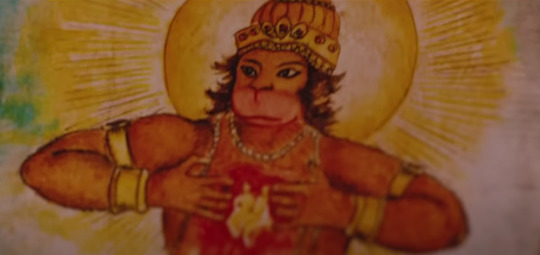
Usually, I talk about JTTW and Sun Wukong but this new movie trailer inspired me to take a look into this monkey god. Hanuman is the most celebrated and worshipped figure in Indian religion. And said to be the inspiration for Sun Wukong.
(What I wrote I just right what I learned from some research please don't hesitate to commoner below if I got anything wrong or missed anything Thank you. :) )
There are several stories told to explain Hanuman's origins.:
One interpretation Shiva and Parvati decided to transform themselves into monkeys in the forest. As a result, Parvati becomes pregnant. Shiva directs the wind god Vayu to carry the offspring from Parvati's womb to that of Anjana - an Apsara with the form of a monkey who has prayed to be granted a boy.
According to Hindu legends, Hanuman was born to mother Anjana and father Kesari.
Hanuman is also called the son of the deity Vayu (Wind god) because of legends associated with Vayu's role in Hanuman's birth and is said to be the incarnation of Shiva (Destroyer god)
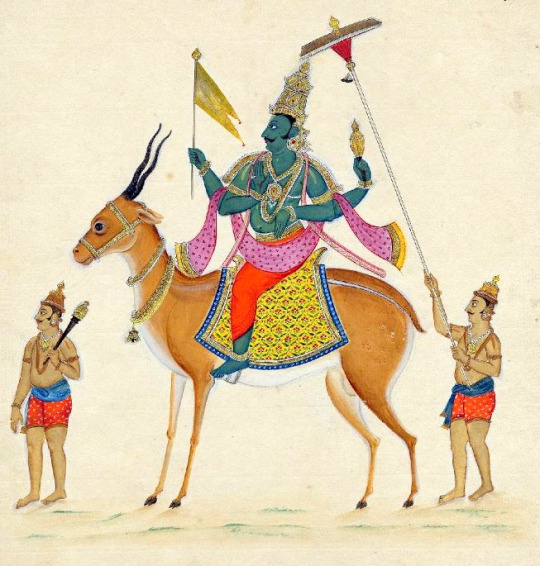
image above (Vayu)
Another tale of his birth is "when Anjana was worshiping Vayu, the King Dasharatha of Ayodhya was also performing the ritual of Putrakameshti yagna to have children. As a result, he received some sacred pudding (payasam) to be shared by his three wives, leading to the births of Rama, Lakshmana, Bharata, and Shatrughna. By divine ordinance, a kite snatched a fragment of that pudding and dropped it while flying over the forest where Anjana was engaged in worship. Vayu delivered the falling pudding to the outstretched hands of Anjana, who consumed it, leading to the birth of Hanuman".
The majority of the stories contain Vayu and Anjana.
Similar to Wukong Hanuman had a youth full of mischief (usually with the gods and sages) and some familiar powers.
"As a youth Hanuman often abused his powers to pester the saints and holy men living in a nearby forest, with tricks such as beard pulling and the dousing of sacred fires. However, it is as an adult that the monkey god Hanuman comes into his own."
"Indra, the king of the gods, struck Hanuman with a thunderbolt on the jaw(hanu), thus inspiring the name. When Hanuman continued to misbehave, powerful sages cursed him to forget his magic powers, such as the ability to fly or to become infinitely large, until he was reminded of them."
"The god Indra grants Hanuman a wish that his body would be as strong as Indra's Vajra and that his Vajra can also not harm him. Along with Indra other gods have also granted him wishes: the God Agni granted Hanuman a wish that fire won't harm him; God Varuna granted a wish for Hanuman that water won't harm him; God Vayu granted a wish for Hanuman that he will be as fast as wind and the wind won't harm him. Brahma also granted Hanuman a wish that he could move to any place where he could not be stopped. Hence these wishes make Hanuman an immortal, who has unique powers and strength."
"He is said to have transformed into the size of mountain, and flew across the narrow channel to Lanka." "he shrinks down to the size of an ant and sneaks into the city." "Upon arriving, he discovered that there were many herbs along the mountainside, and did not want to take the wrong herb back. So instead, he grew to the size of a mountain, ripped the mountain from the Earth, and flew it back to the battle. "

How the two are not alike is Hanuman was a being who wanted nothing to do with immortality and wanted to serve the Rama. Nothing like the free spirit and immortally seeking Wukong.
"After blessing all those who aided him in the battle with gifts, Rama gave Hanuman his gift, who threw it away. Many court officials, perplexed, were angered by this act. Hanuman replied that rather than needing a gift to remember Rama, he would always be in his heart. Some court officials, still upset, asked him for proof, and Hanuman tore open his chest, which had an image of Rama and Sita on his heart.
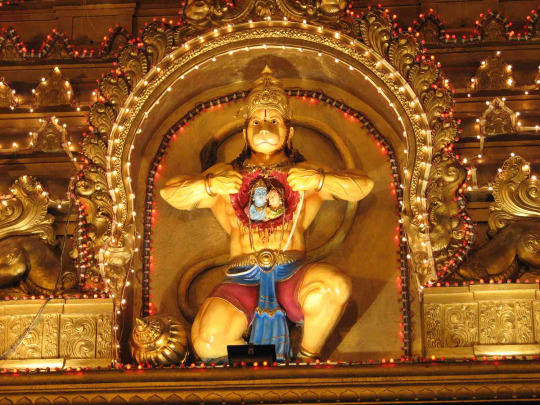
Now proven as a true devotee, Rama cured him and blessed him with immortality, but Hanuman refused this and asked only for a place at Rama's feet to worship him. Touched, Rama blessed him with immortality anyway. Like Shesha Nag, Hanuman would live on after the kalpa (destruction of the universe)."
Fun Fact:
The namesake " One interpretation of "Hanuman" is "one having a disfigured jaw". It is due to that earlier tale of Indra striking him as a child in the jaw with a lightning bolt. Because child Hanuman mistook the sun for a fruit and tried to take a bite.
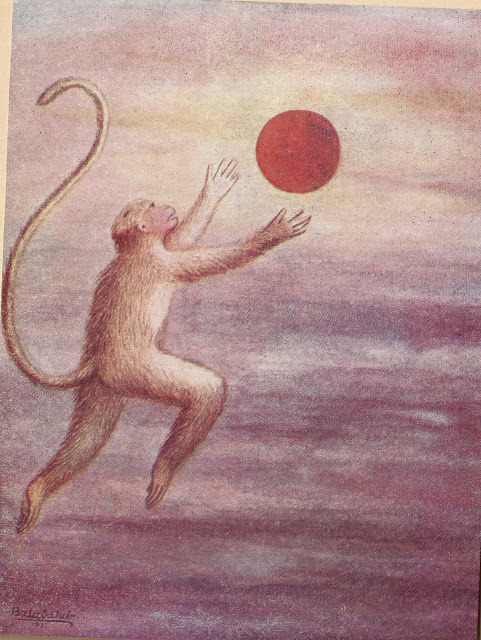
That then leads to the other gods and Indra giving him powers and wishes. There is another version the other is he was burned to ash and was brought back but had a bad jaw when he was restored.
"Though Hanuman is described to be celibate in the Ramayana and most of the Puranas, according to some regional sources, Hanuman married Suvarchala, the daughter of Surya (Sun-God). However, once Hanuman was flying above the seas to go to Lanka, a drop of his sweat fell into the mouth of a crocodile, which eventually turned into a baby. The monkey baby was delivered by the crocodile, who was soon retrieved by Ahiravana, and raised by him, named Makardhwaja, and made the guard of the gates of Patala, the former's kingdom. One day, Hanuman, when going to save Rama and Lakshmana from Ahiravana, faced Makardhwaja and defeated him in combat. Later, after knowing the reality and after saving both, he made his son, the king of Patala.o"
(Can't wait to see the movie Monkey Man when it comes out:))
24 notes
·
View notes
Text
There will never be anything more despicable than building and celebrating, and forcing a nation to celebrate on the taxpayers money, a temple build on the mass graves of Muslims. The Hindu nationalist state, has proved again that this nation belongs to only Hindus.
Babri Masjid, 1992
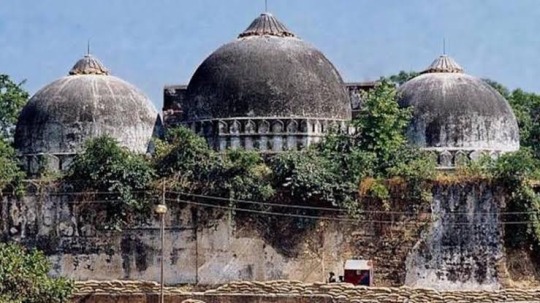
Ram Temple, 2024
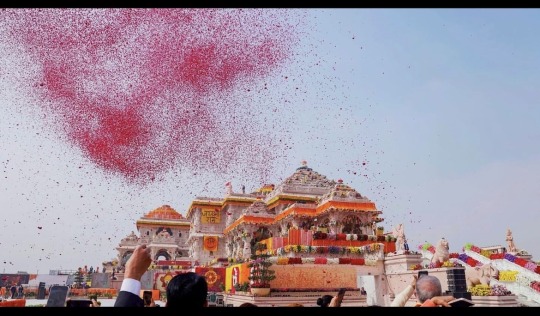
A bit of context for those who don’t know about the issue:
Babri Masjid, was a mosque in Ayodhya, India. It was built in the 16th century by the Mughal Empire. Babri Masjid was a holy place for the Muslims in the country. There’s a history of communalism (created by the British Empire) between Hindus (the majority religion) and Muslims (the minority) in the country.
In 1992, Babri Masjid was attacked and demolished by Hindu extremists who believed that the mosque was built on the site of birthplace of Ram (Hindu god). Thousands of people lost their lives. Thousands of Muslims were killed in cold blood by a hyper-nationalist state.
In 2010, after decades of Muslims fighting for justice, the Allahabad High Court upheld the claim that the mosque was built on Ram’s birth place. Muslims were also awarded one-third area of the site for the construction of a mosque. However, thr decision was subsequently appealed by all parties to the Indian Supreme Court, wherein a five judge bench heard a title suit from August to October 2019. On 9 November 2019, the Supreme Court quashed the lower court's judgement and ordered the entire site to be handed over to a trust to build the Hindu temple.
Today, 22nd January, 2024, marks the inaugural of the Ram Temple in Ayodhya. On a site that is so deeply entrenched within a community’s blood, pain and trauma. While these Hindu nationalists celebrate, every Muslim in the country feels more scared. Muslims in India have always been unlawfully detained, persecuted, punished and killed throughout the past seven decades but it has only worsened ever since BJP, the ruling party came in power. Celebrities, sportsperson, politicians and millions of people travelled to Ayodhya to celebrate this tremendous failure of the state.
Today, the Indian constitution lies under those thousands grave.
If any one of you celebrated, I hope you understand the gravity of your actions. I hope you understand what you all set in motion. I hope that one day, you understand and that there is no redemption for you after that.
I hope you all rot in hell.
Here’s a short poem by Rabindranath Tagore about an old god, a new temple, an arrogant king and many hungry and homeless ordinary people.
13 notes
·
View notes
Text

On the matter of tRump…in 3 posts…
Post 3 -
Democracy is a dangerous game. Like any game of chance, it can deal you good or bad 'cards'. Trick is to make the most of what you have been given and take advantage of any mistake your opponent makes.
Democracy gave us Obama. Democracy also gave us tRump. Both chosen by the same generation. Both Presidents chosen by the same electorate!
The same citizens who cried, praised and pitied the fate of Sita as she followed Rama in to exile, gossiped behind her back and didn't even raise a finger to help her when she was exiled with her twins. No one even went to see how she was doing.
Once the beloved princess of Videha, queen of Ayodhya and wife of the virtuous Rama, she lived a life of neglected celebrity in an ashram in the forest. No one from Videha, Ayodhya, Kishkindha or Lanka came to see her. No paparazzi, no busy-body journalist.
In the quiet of the Ashram, she wrote her biography and called it 'Ramayan'. It was a mirror to Rama and asked him - how 'just' is your Rama-Rajya if it failed your own queen and sons.
Let us see how this chapter in history turns out when our descendants ask the American voters, HOW did you choose tRump as your President - not once, but twice! Just like the citizens of Ayodhya, they are waiting for the 'war horse' to return so they can perform their own AshwaMedha Yagna to prove global dominance by America!
I have yet to see an AshwaMedha Yagna go well for anyone! Even at the time of Prachin Baharshi, when the universe was still young, Indra intervened and his yagna failed. Even the yagna of Daksha, to celebrate his title as PrajaPati, went awry and was badly destroyed. Pride and haughty proclamations always seem to attract jealousy, ego, discord and a downfall.
At a time when all the thrones of Europe were occupied by the descendents of MahaRani Victoria, grandmother of Emperors, kings, princes and petty aristocrates, the British Empire could make a boast that would make an assembly of previous emperors blush with envy - The Sun does not set in the British Empire! Within two generations, two wars smashed 10 empires to smithereens, including the British.
Every era has had its heros and villians. Even in Sat Yug, much applauded by people, there were several villains of magnificent proportion! Let us see who the villains of this new chapter in Kali Yuga will be. I have every faith that the author and director of this magnificent play (Lila) will entertain, surprise,awe, thrill and scare us before revealing a final twist in the play.
We have read the Ramayan and the Mahabharat. Let us see what the next epic contains!
2 notes
·
View notes
Text
Indian Prime Minister Narendra Modi has inaugurated a grand temple to Hindu god Ram in the flashpoint city of Ayodhya.
He said it heralded "a new era" for India - the temple replaces a 16th-Century mosque torn down by Hindu mobs in 1992, sparking riots in which nearly 2,000 people died.
Top film stars and cricketers were among guests at the event in Ayodhya.
But some Hindu seers and most of the opposition boycotted it, saying Mr Modi was using it for political gain.
General elections are due in India in the next few months and Mr Modi's political rivals say the governing Bharatiya Janata Party (BJP) will be seeking votes in the temple's name in a country where 80% of the population is Hindu.
Critics have also accused the government of exploiting a religious celebration in a country which - according to its constitution - is secular. For Muslims, India's biggest minority, the event evoked fear and painful memories, members of the community in Ayodhya told the BBC in the run-up to Monday's ceremony.
Televised live, it showed Mr Modi performing religious rituals inside the temple's sanctum along with priests and Mohan Bhagwat, head of the Rashtriya Swayamsevak Sangh (RSS) - the ideological fountainhead of Hindu nationalist parties.
The complex history of India's Ayodhya holy site
Transforming a flashpoint holy city into the ‘Hindu Vatican’
"Today's date will go down in history," Mr Modi said after the event. "After years of struggle and countless sacrifices, Lord Ram has arrived [home]. I want to congratulate every citizen of the country on this historic occasion."
The temple has been constructed at a cost of $217m (£170m), funded from private donations. Only the ground floor was opened - the rest is expected to be completed by the end of the year. The construction work is part of a revamp for the city, estimated to cost more than $3bn.
The building of the Ram temple in Ayodhya fulfils a decades-long Hindu nationalist pledge. Many Hindus believe the Babri mosque was built by Muslim invaders on the ruins of a temple where the Hindu god was born.
The movement to build the temple helped propel the BJP into political prominence in the 1990s.
There was a festive atmosphere as tens of thousands of chanting Hindu devotees waved flags and beat drums - military helicopters showered flower petals on the temple. Saffron flags with pictures of Lord Ram line streets in the city festooned with marigolds, as do banners with the faces of Mr Modi and Uttar Pradesh Chief Minister Yogi Adityanath.
Some of India's biggest celebrities, including Bollywood star Amitabh Bachchan and cricketer Sachin Tendulkar, attended.
Temple rises from ruins of one of India’s darkest days
Listen: The temple at the heart of Modi's India re-election bid
Transforming a flashpoint holy city into the ‘Hindu Vatican’
In many other northern cities Hindus lit lamps, and saffron flags carrying images of Ram are fluttering on rooftops, including in several parts of Delhi. Cinemas screened the event, and big screens relayed pictures from Ayodhya to town squares and residential neighbourhoods.
The ceremony, called Pran Pratishtha, which loosely translates from Sanskrit into "establishment of life force", lasted about an hour. Hindus believe that chanting mantras and performing rituals around a fire will infuse sacred life in an idol or a photograph of a deity.
Several domestic TV stations built huge sets by the side of the river Saryu, a tributary of the Ganges, just behind the temple, and provided wall-to-wall coverage of the event, some proclaiming the moment of consecration as the start of "Ram Rajya" (Lord Ram's rule) in India.
Hindus celebrated the inauguration in other countries too. Massive billboards of Lord Ram graced Times Square in New York, where a group of devotees braved the freezing weather to gather in the middle of the night.
Temples all across the United Kingdom - where Indians are one of the largest diaspora groups - marked the event. Colourful posters had been shared inviting devotees to honour the occasion and celebrations involved flowers, sweets and music. There were also some celebrations in Muslim-majority Dubai - where Indians are a significant population - but from Indian news reports these appeared more muted than elsewhere.
In 2019, the Supreme Court gave the disputed land to Hindus after a protracted legal battle followed the mosque's demolition. Muslims were given a plot outside the city for a mosque but have yet to build one.
One member of the community the BBC spoke to in Ayodhya ahead of Monday's inauguration agreed that Hindus have the right to build the temple after the Supreme Court gave them the site.
"We did not accept that decision happily, but what can we do," he said. Another man said he was happy Hindus are building the temple - "but we are also sad because it was built after destroying a mosque".
The new three-storey temple - made with pink sandstone and anchored by black granite - stretches across 7.2 acres in a 70-acre complex. A 51-inch (4.25-ft) statue of the deity, specially commissioned for the temple, was unveiled last week. The idol has been placed on a marble pedestal in the sanctum sanctorum.
Thousands of police were deployed for Monday's event, despite Mr Modi having appealed to pilgrims not to turn up and to watch the ceremony on television. In many states a full or half day holiday was called, with schools and colleges closed and stock markets shut.
The build-up to a demolition that shook India
The man who helped Lord Ram win the Ayodhya case
But a sour note was struck with some top religious seers saying that as the temple was not yet complete, it was against Hinduism to perform the rituals there, and many opposition leaders deciding to stay away.
Some opposition-ruled states also announced their own plans for the day - West Bengal Chief Minister Mamata Banerjee said she would pray at the iconic temple to goddess Kali in Kolkata and then lead an all-faith rally. The eastern state of Odisha (Orissa) unveiled huge plans to bring pilgrims to the Jagannath temple in Puri, one of the holiest sites for Hindus.
Authorities say they expect more than 150,000 visitors per day once the temple in Ayodhya is fully ready.
To accommodate this expected rush, new hotels are being built and existing ones spruced up as part of a major makeover and in recent weeks, a new airport and railway station have opened.
Officials say they are building a "world-class city where people come as pilgrims and tourists", but many local people have told the BBC that their homes, shops and "structures of religious nature" have been either completely or partially demolished to expand roads and set up other facilities.
7 notes
·
View notes
Text
Which deity is more popular in North India, Lord Ram or Lord Krishna?
Imagine walking through the lively streets of North India, where every corner holds a new tale, a fresh festivity, and a deity waiting to be honored. Now, let's dive into the enchanting world of Lord Ram and Lord Krishna, two beloved figures who weave their magic through the hearts of the people.
In Uttar Pradesh, where Ayodhya proudly proclaims itself as Ram's birthplace, there's a palpable sense of devotion that fills the air, especially during Ram Navami and the dazzling Diwali festival. It's as if the entire town bursts into life, painting the streets with vibrant colors and echoing chants, all celebrating Ram's virtues of righteousness and duty.
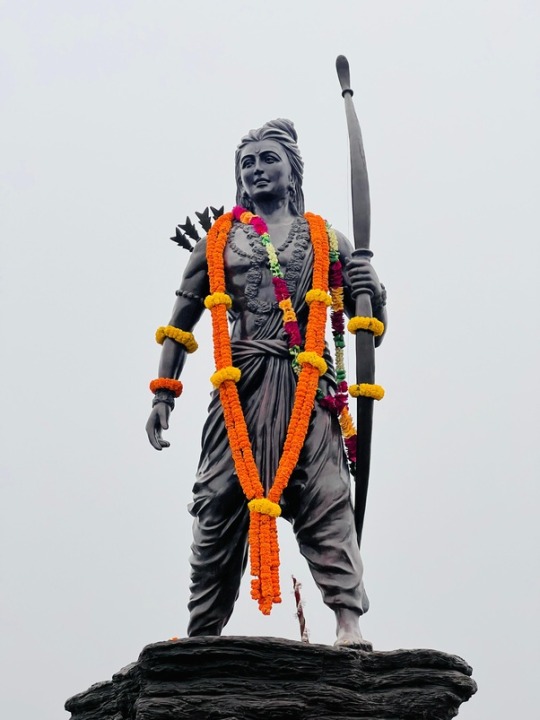
But take a stroll into the cozy lanes of Vrindavan and Mathura, and you'll find a different kind of enchantment. Here, it's all about Krishna – the charming trickster whose flute melodies and playful antics stole the hearts of all who encountered him. During Janmashtami, the celebration of his birth, these towns transform into whirlwinds of joy and festivity, as if Krishna's laughter still dances through the air.
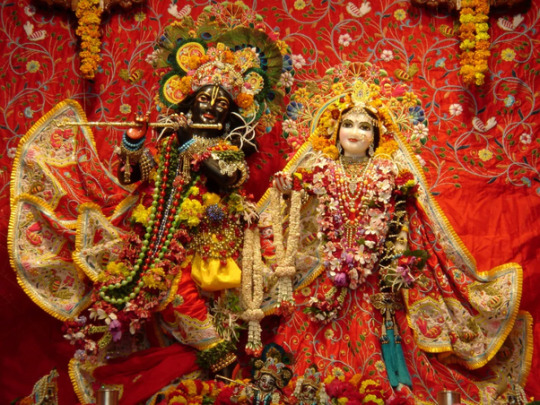
What's truly captivating is how deeply people connect with these divine beings. For some, it's Ram's unwavering strength and moral compass that resonate in their souls, guiding them through life's challenges. For others, it's Krishna's playful wisdom, especially as the charioteer in the Bhagavad Gita, that offers comfort and guidance in times of uncertainty. It's like choosing a beloved character from a cherished story – each one speaks to us in a unique way, touching our hearts and shaping our beliefs.
Ultimately, it's not about who's more popular or who receives the most offerings. It's about forging a personal connection with the divine, finding solace and inspiration in their stories and teachings. Whether we're drawn to Ram's sense of duty or Krishna's playful charm, Hinduism offers a rich tapestry of beliefs that invites us to explore, connect, and find our own path to the divine, guided by the warmth of human emotion and connection."
Certainly! Both Lord Ram and Lord Krishna offer profound teachings that continue to inspire millions of people worldwide.
Learnings from Lord Ram:
Duty and Responsibility: Ram epitomizes the principle of duty and responsibility. His unwavering commitment to upholding dharma (righteousness) and fulfilling his responsibilities as a son, husband, and king teaches us the importance of fulfilling our duties with dedication and integrity.
Resilience in Adversity: Ram's life is marked by numerous challenges and trials, including exile from his kingdom and the abduction of his wife, Sita. Yet, he faces each adversity with courage, resilience, and grace, teaching us the value of perseverance and steadfastness in the face of hardship.
Compassion and Forgiveness: Despite the injustices he faces, Ram embodies compassion and forgiveness. His willingness to forgive even those who wronged him, such as Ravana, demonstrates the power of compassion and the importance of letting go of resentment.
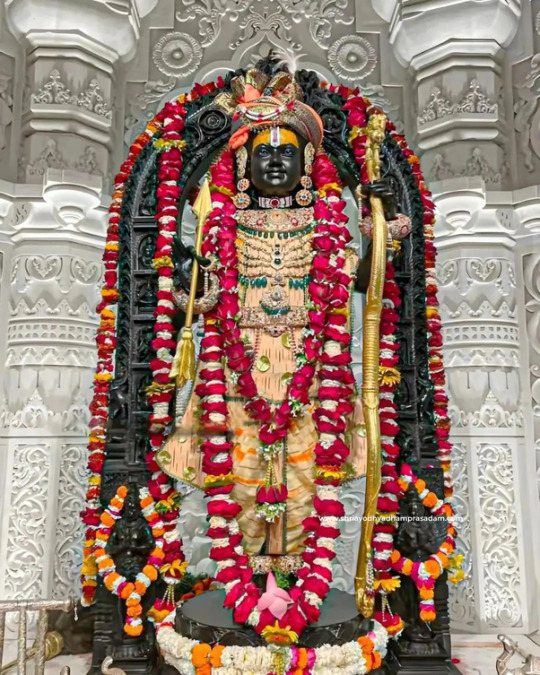
Learnings from Lord Krishna:
Wisdom and Guidance: Krishna, often revered as the divine teacher, imparts profound wisdom and guidance to Arjuna in the Bhagavad Gita. His teachings on duty, righteousness, and the nature of existence provide invaluable insights into navigating life's complexities with wisdom and clarity.
Detachment and Surrender: Krishna emphasizes the importance of detachment from the fruits of our actions and surrendering to the divine will. By relinquishing attachment to outcomes and surrendering to the greater cosmic plan, we can find inner peace and liberation from suffering.
Devotion and Love: Krishna's divine love and devotion, particularly in his interactions with his devotees like Radha, exemplify the power of unconditional love and devotion in forging a deep connection with the divine. His teachings remind us of the transformative power of love in transcending worldly boundaries and experiencing spiritual union.
In essence, the teachings of Lord Ram and Lord Krishna offer timeless wisdom and guidance for navigating life's journey with integrity, resilience, compassion, and spiritual insight.
"Explore Ayodhya and Sanatan Dharma's essence with us! Visit our website http://www.shriayodhyadhamprasadam.com to dive into their timeless wisdom and offerings.
Let’s sustain and spread essence of our dharma together. Join the journey now!"
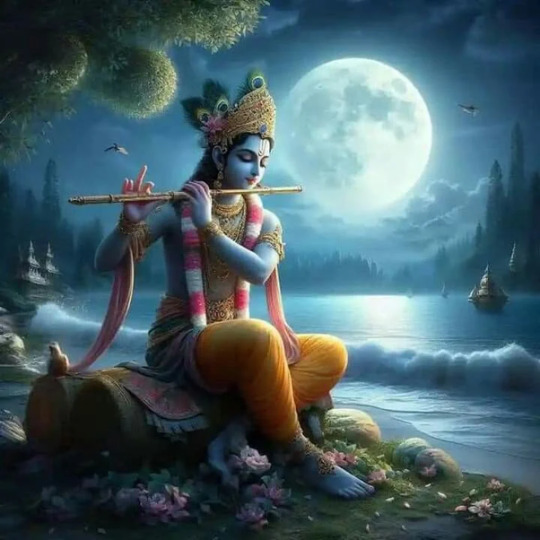
#ayodhya#ram mandir#jai shree ram#bharat#inspirational quotes#ramayana#ayodharammandir#vrindavan#hare krishna#uttarpradesh#branding#north india tour#india#sanatandharma#sanatani#hinduism
5 notes
·
View notes
Text
"Driving through the Mira Road neighbourhood of Mumbai was a usual affair for 21-year-old Mohammad Tariq, who ran errands on his father’s white loading auto carrier.
But on Tuesday, participants in a Hindu nationalist rally stopped the vehicle in the middle of the road. Young boys – mostly teenagers – dragged him out. They punched and kicked him and thrashed him with batons, flag staffs and iron chains, his 54-year-old father, Abdul Haque told Al Jazeera. Since then, Haque said, “[Tariq] has been terrified.”
The rally, which was shared over multiple live streams, turned into a mob, targeting several Muslims in the locality, rampaging through their shops and damaging vehicles while chanting “Jai Shri Ram” (Victory to Lord Ram). Similar rallies, often to the beat of booming far-right pop music, took place outside mosques and Muslim neighbourhoods across several states in India.
The trigger was the consecration of a Ram temple in the ancient city of Ayodhya in northern India by Prime Minister Narendra Modi on Monday. The temple is being built on the site where the 16th century Babri Masjid stood until 1992, when Hindu far-right mobs tore down the mosque, triggering nationwide riots that killed more than 2,000 people, mostly Muslims."
5 notes
·
View notes
Text
Episode : 13 | नवरात्रि के अवसर पर आध्यात्मिक बहस | 17-04-2024 | Sadhna ...
#GodMorningThursday
#ThurdayThoughts
#Who_Is_AadiRam
👑 Kabir Is God👑
#असली_सनातन_हितेषी_कौन
#FactfulDebates
Sant Rampal Ji Maharaj
YouTube Channel
#देवी_मां_को_ऐसे_करें_प्रसन्न
#GyanGanga
#GyanGanga_AudioBook
#नवरात्रि #navratri2024
#AadiRam
#Kabir_Is_God #ram #ramnavami #RamLalla #ayodhya #rammandir #news #viral #trending #ceremony #trendingreels #trend #viral #viralreels #India #World #vedio
#SantRampalJiMaharaj
#SatlokAshram
2 notes
·
View notes
Text
Last week, the Indian state of Uttarakhand passed a bill to adopt a controversial Uniform Civil Code (UCC), which will bring an end to religious or personal laws governing marriage, divorce, adoption, and inheritance, among other issues. The change will bring all communities together under a common law to regulate those practices. The new legislation has already faced pushback from Muslim leaders and other members of India’s political class.
Indian Prime Minister Narendra Modi and the ruling Bharatiya Janata Party (BJP) hope that Uttarakhand will serve as a model for the introduction of a UCC across India, or at least across BJP-ruled states. Some of these states, including Assam and Modi’s home state of Gujarat, are already considering their own UCC bills and are keen to use the Uttarakhand code as a template, although they may tweak the legislation to address local needs. Despite its seeming impartiality, the UCC pushed by the BJP would be a threat to India’s religious pluralism.
The idea of a UCC has long caused consternation among India’s religious minorities, especially Muslims. Muslim politicians and religious leaders have suggested a UCC would amount to unwarranted interference in their community’s norms, especially when it comes to specific legal protections related to marriage, divorce, and inheritance. The Uttarakhand code even regulates live-in relationships—a clear nod to conservative Hindus, many of whom frown on such arrangements.
These critics’ misgivings are not without merit. The BJP has long pursued three contentious goals that impinge disproportionately on the interests of the Muslim community: the abolition of Article 370 of the Indian Constitution, which granted special autonomous status to the Muslim-majority state of Jammu and Kashmir; the construction of a Hindu temple in the city of Ayodhya on the site of a mosque demolished by a Hindu mob in 1992; and the adoption of a nationwide UCC. It achieved the first goal in 2019, and the Ram Mandir in Ayodhya is not yet complete but was consecrated last month.
However, the idea of a UCC goes back decades to India’s foundations as an independent state. The subject was extensively debated by the constituent assembly that helped forge India’s constitution in 1949, but it was not resolved. Owing to the sensitivities of religious communities, most notably Muslims, no government was willing to tackle the politically fraught question. So why is it the unabashedly pro-Hindu BJP government—and not one controlled by the Indian National Congress party, which is committed to secularism—that has taken up the issue of the UCC? The answer requires a bit of historical exegesis.
The prevalence of separate personal laws for different religious communities in India can be traced to a colonial-era regulation. Warren Hastings, then the governor of Bengal and later the first British governor-general of India, directed in 1772 that “in all suits regarding inheritance, marriage, caste and other religious usages and institutions, the laws of the Koran with respect to the Mahomedans and those of the Shaster with respect to Gentoos [Hindus] shall be invariably adhered to.” In 1937, the British Raj enacted the Muslim Personal Law (Shariat) Application Act, which codified Islamic law for marriage, divorce, succession, inheritance, and other family affairs.
Those who drafted the Indian Constitution debated the necessity of a UCC, with most Muslim members against it. One of the principal architects of the constitution, B.R. Ambedkar, argued that if India could have a common criminal code, it could also have common personal laws, and suggested that a uniform civil code initially be voluntary. The framers instead settled for Article 44, a set of non-justiciable directives that range from prohibiting cow slaughter to curbing liquor consumption. It also called on the Indian state to endeavor toward a UCC for its citizens.
During Indian Prime Minister Jawaharlal Nehru’s first term (1952-1957), the Congress party succeeded in codifying Hindu personal law through four pieces of legislation in the face of opposition. Conservative forces decried the move to meddle with Hindu personal laws, while reformists wondered why the changes were restricted to Hindus alone. But when asked about a uniform civil code, Nehru said that the time was not ripe for it.
The matter largely remained unaddressed until 1978, when Shah Bano—a recently divorced Muslim woman—sued her former husband in a lower court in central India for not providing alimony in accordance with the Indian penal code. The local court awarded Bano monthly basic maintenance, which was later increased by a high court. Bano’s husband, Mohammed Ahmad Khan, later challenged the matter before the Indian Supreme Court. Khan contended that he was not obliged to support his former wife under Muslim personal law because he had paid a dowry and three months’ maintenance.
In 1985, the Supreme Court not only rejected Khan’s appeal, but also came out in support of a nationwide UCC. At the time, Chief Justice of India Y.V. Chandrachud—the father of the current chief justice—asked why Article 44 remained a “dead letter,” noting that the Indian state lacked the “political courage” to enact a UCC. The judgment created a firestorm, especially among the Muslim community.
The Congress government led by then-Prime Minister Rajiv Gandhi responded by passing the Muslim Women (Protection of Rights on Divorce) Act in 1986, which said that maintenance had to be paid only for the waiting period for a widowed or divorced woman, usually three months—effectively nullifying the Supreme Court ruling. The new law doused the controversy for the moment, but it also opened up the Congress government to charges of so-called minority appeasement. Today, the BJP tends to characterize the Congress party and others as placating Muslims and other religious minorities in the name of secularism.
Since the Shah Bano case, several court rulings have whittled away at Muslim personal law—but none more so than the 2017 Supreme Court ruling that determined the practice of instant triple talaq to be unconstitutional. The ruling came in response to women’s petitions challenging the practice, in which Muslim men can divorce their wives by uttering “talaq” (divorce) three times in quick succession. Indians across the political spectrum welcomed the judgment for advancing women’s rights, but some observers saw it as another step toward a UCC. The BJP government followed up with the Muslim Women (Protection of Rights on Marriage) Act in 2019, which made triple talaq a punishable offense.
The UCC indeed has the potential to bolster women’s rights in India by doing away with the anachronistic traditions of some religious groups. But improving the lot of Indian women does not appear to be what drives the BJP. Instead, the party’s pursuit of a UCC appears to be an attempt to stigmatize a particular faith under the guise of enhancing the status of women. (After all, if the BJP were truly concerned about women’s autonomy, it would not have sought to ban the dubious concept of love jihad, which suggests that Muslim men insidiously entice Hindu women into marrying them under questionable circumstances.)
Uttarakhand’s adoption of a UCC is a step toward fulfilling one of the BJP’s key election promises and a staple of its manifestos for the last three decades. Goa is the only other state that currently has a UCC, but its common law dates to the 19th century, when the state was under Portuguese rule. Despite efforts in other BJP-ruled states, a nationwide UCC may be some time away. Still, both Modi and Indian Home Minister Amit Shah have spoken about the idea, with Shah saying recently that the BJP “remains steadfast in bringing in UCC.”
India’s current political climate is far more amenable to the idea of a UCC than in the past. Modi and the BJP are very popular, and unlike the Congress party, they do not rely on Muslim voters to win elections. However, the situation is complicated by the fact that other religious minority groups such as Sikhs, as well as indigenous communities and the Dalit community, feel the potential of a UCC to infringe on religious and cultural rights. (The Uttarakhand code exempts the indigenous peoples of the state, who make up 3 percent of the state population but are present in greater numbers elsewhere.)
The BJP has succeeded in achieving its long-held goals in Indian-administered Kashmir and in Ayodhya. India’s national election is swiftly approaching, and the Modi government has a seemingly inexorable commitment to its Hindu nationalist agenda. If it returns to power this spring with a clear-cut parliamentary majority, the implementation of a nationwide UCC will likely figure prominently in its political priorities, pushing back against what remains of India’s commitment to religious pluralism.
2 notes
·
View notes
Text
Seek Lord Ram's Forgiveness, Because…": PM Modi On Ayodhya Temple
Addressing the large gathering after the 'pran pratistha' rituals at the grand Ram Temple in Ayodhya, Prime Minister Narendra Modi today said, "Our Ram has finally arrived." "I have come before you are witnessing the divine consciousness in the temple's sanctum sanctorum. There's so much to say but, but there's a lump in my throat. After unprecedented patience, innumerable sacrifices and penance, our Lord Ram has arrived. I congratulate the country on this occasion," the Prime Minister said.

Ram Lalla, he said, will "no longer live in a tent". Saying that this moment of consecration is a blessing from Lord Ram, he said January 22 is "not a date on a calendar, but the dawn of a new era".
Equating the consecration ceremony with breaking free of a mindset of slavery, he said it is a blessing that we are alive to witness this historic event. "Even after thousands of years, people will remember this date, moment. It is Ram's supreme blessings that we are witnessing it," he said. He also sought forgiveness from the deity and said there must have been some lapse because of which it took so long to reach this point.
Saying that "Ram's existence was questioned", the Prime Minister said, "In India's Constitution, in its first page, there's Lord Ram. I thank the Supreme Court for maintaining the dignity of law."
Some people, he said, had warned that the construction of the Ram Temple will light a fire. "Such people could not understand the purity of India's social consciousness. The construction of this temple of Ram Lalla is also a symbol of the Indian society's peace, patience and mutual harmony. We can see this has not given birth to a fire, but an energy," he said.
"Ram is not a fire, he is an energy. Ram is not a dispute, he is a solution. Ram is not just ours, he is everyone's," the Prime Minister said, adding, "Today, we did not just see the pran pratishtha of Ram Lalla's idol, but also the pran pratishtha of the unbreakable unity of India."
Laying down a vision for the country's development in the future, the Prime Minister said, "Ram's temple has been built. Now what? Every citizen's consciousness should extend from dev (god) to desh (country) and from Ram to rashtra (nation)."
2 notes
·
View notes
Text
8 Most Famous Festivals in India
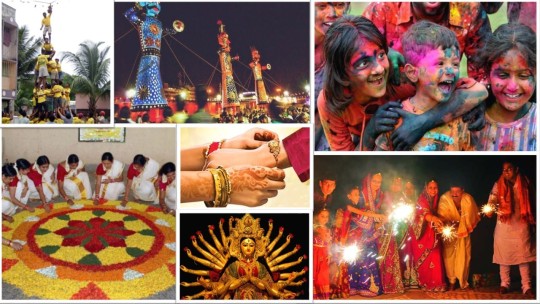
India is known for its multitude of festivals and the peaceful coexistence of people from different religious backgrounds. These festivals are a true representation of India's rich cultural heritage and traditions. There are several festivals and celebrations. While there are celebrations throughout the year, the country is at its most colorful from October to January. Every religion and community in India practice their own culture and enjoy it to the fullest. India celebrates holidays according to state, religion, and society. Festivals in India are never ending and every day is something to celebrate.
Diwali
The nation commemorates Lord Rama's homecoming to Ayodhya after a 14-year exile by lighting diyas, making rangolis, adorning homes, donning new garments, giving out presents, and setting off fireworks. People also revere Lord Ganesha, who represents moral beginnings, and Goddess Lakshmi, the Goddess of riches and prosperity. In West Bengal and Odisha, it is referred to as Kali Puja. It is known as Bandi Chor Diwas in Sikhism, and around this time, worshippers light the Golden Temple of Amritsar and enjoy fireworks displays. All around the nation, Diwali melas are organized. In Karnataka, there is a five-day celebration, which can be witnessed during India tours. In the Braj region, Diwali is devoted to Lord Krishna, and as a result, they worship Govardhan Mountain. There is a lot of fervor and spectacle around the Festival of Lights.
Republic Day
India became a republic on January 26, 1950, when the Indian Constitution went into effect. Since then, Indians have proudly celebrated the national holiday on January 26 each year. The festivities take the form of ceremonial marches at Rajpath in front of the Indian President and other foreign dignitaries. Numerous thousands of people come to the venue to watch the spectacle showcasing the nation's unity and cultural diversity. You need to register for this event from government websites during your India tour packages.
Holi
The festival of colors is the friendliest holiday in the nation. The night before Holi is Holika Dahan, when all negativity is burned in a bonfire. People play with organic colors while grooving to music on the main day. The festival's signature dishes include Gujiya, Mathri, and Thandai. In the Mathura district of Bhaj, Lathmar Holi is observed. Sticks were used by women to amusingly beat their husbands' shields. Offerings are made to Kamadeva, the Hindu god of love, throughout the south. In Gujarat's coastal city of Dwarka, the event is observed at the Dwarkadheesh Temple. It is celebrated as the holiday of reconciliation and fresh starts.
Rath Yatra, Puri, Orissa
The largest celebration observed in Puri is the Rath Yatra. In Puri's primary Jagannath temple, the deities Lord Jagannath, Lord Balabhadra, and Goddess Subhadra are carried away on the heavenly wheel and placed in their corresponding chariots. The chariots are then driven up to the Gundicha Temple's grand avenue. Participants in this Yatra number in the thousands. This Yatra is also shown live on foreign channels.
Krishna Janmashtami
The birth of Lord Krishna is commemorated each year by a Hindu event. The holiday is observed differently in each state. The traditional Krishna play, Rasa Lila, is performed throughout the states of Gujarat, Manipur, Assam, Rajasthan, and Mathura. The Dahi Handi festival is held in Mumbai, Pune, and Gujarat, during which groups construct human pyramids to reach a yogurt pot that is suspended at a specific height. In Gujarat, traditional dances are presented at the temples. Farmers in Gujarat's Kutch region paint bullock carriages with Krishna statues to perform pageants. People participate in devotional songs and celebrate the holiday in North East and South India, respectively. The most important Indian festivals are observed in Mathura, Vrindavan, and ISKCON.
Durga Pooja
The festival honors Goddess Durga's victory over Mahishasura and the triumph of good over evil. In the eastern and north-eastern states of India, it is celebrated over a period of ten days and is a significant social occasion. The believers take pleasure in the lengthy and intricate procedures. You are surrounded by colorful streets, pandals, bhajans, and dazzling lights throughout the festival season. Additionally, to commemorate Maa Durga's victory over the buffalo demon, actual animal sacrifices are made at the temples of West Bengal, Odisha, and Assam. In Karnataka, it is known as Mysore Dasara. The scheduled dates could change.
Rann Utsav, Kutch, Gujrat
Visitors are cordially welcomed in the White Desert. The celebration continues until February. The vibrant fairs at the river's edge enhance people's spirits with a festive spirit. There are activities like horseback riding, camel riding, bird watching, traditional dances, various games, giant chess, paramotoring, and net cricket, to name a few. The festivals in India offer guests an opportunity to get a taste of the many customs and friendliness of the Kutchi people. Everyone enjoys looking at white sand that has colorful ornaments.
Hornbill Festival, Nagaland
The Hornbill Festival, often known as the Festival of Festivals, takes place annually from December 1–7. a distinctive traditional event that takes place in Nagaland, a state in northeastern India. Nagaland is a multiethnic state that is home to various tribes. The state tourism and arts & culture agencies of Nagaland organize the Hornbill Festival to highlight the culture and ethnicity of the region and to promote interaction between various tribal tribes.
Conclusion
India's festivals are a vibrant tapestry of cultural diversity, reflecting the nation's rich heritage. From the dazzling lights of Diwali to the colors of Holi and the grandeur of Republic Day, these celebrations are a testament to India's unity in diversity. The Rath Yatra in Puri, Krishna Janmashtami's joyous festivities, and the grandeur of Durga Puja in the east showcase the country's deep-rooted traditions.
As you plan your journey through India, don't miss these opportunities to immerse yourself in the country's cultural tapestry. Each festival paints a unique picture of India's traditions, making your visit to places in India like Delhi, Kolkata, Mathura, and Nagaland an unforgettable experience.
3 notes
·
View notes